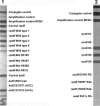Evaluation of the Genotype MTBDR assay for rapid detection of rifampin and isoniazid resistance in Mycobacterium tuberculosis isolates
- PMID: 16825346
- PMCID: PMC1489470
- DOI: 10.1128/JCM.00425-06
Evaluation of the Genotype MTBDR assay for rapid detection of rifampin and isoniazid resistance in Mycobacterium tuberculosis isolates
Abstract
A novel PCR-based reverse hybridization method Genotype MTBDR assay (Hain Lifescience GmbH, Nehren, Germany) was evaluated for rapid detection of rifampin (RIF) and isoniazid (INH) resistance in Turkish Mycobacterium tuberculosis isolates. The Genotype MTBDR assay is designed to detect mutations within the 81-bp hotspot region of rpoB and mutations at katG codon 315. A total of 41 RIF-resistant M. tuberculosis isolates with rpoB mutations that were previously tested by the INNO-LiPA Rif.TB kit and also characterized by DNA sequencing were included in the study. Thirty-seven of these isolates were also resistant to INH. RIF resistance was correctly identified in 39 of 41 isolates (95.1%) with the Genotype MTBDR assay probes specific for these mutations. One isolate with a Gln-490-His mutation and another one with a CGG insertion between codons 514 and 515 were identified as RIF sensitive by the Genotype MTBDR assay. While the INNO-LiPA Rif.TB kit was able to determine the CGG insertion between codons 514 and 515, the Gln-490-His mutation outside the 81-bp hotspot region was not detected by the INNO-LiPA Rif.TB kit. These isolates had MICs of >or=32 microg/ml for RIF. The Genotype MTBDR assay also correctly identified 27 of 37 INH-resistant isolates (73%) with mutations in katG codon 315. In conclusion, the Genotype MTBDR assay may be useful for the rapid diagnosis of the most common mutations found in multidrug-resistant M. tuberculosis strains. However, the test results should always be confirmed with phenotypic methods.
Figures


References
-
- Abate, G., S. E. Hoffner, V. O. Thomsen, and H. Miorner. 2001. Characterization of isoniazid-resistant strains of Mycobacterium tuberculosis on the basis of phenotypic properties and mutations in katG. Eur. J. Clin. Microbiol. Infect. Dis. 20:329-333. - PubMed
-
- Aktas, E., R. Durmaz, D. Yang, and Z. Yang. 2005. Molecular characterization of isoniazid and rifampin resistance of Mycobacterium tuberculosis clinical isolates from Malatya, Turkey. Microb. Drug Resist. 11:94-99. - PubMed
-
- Bodmer, T., G. Zurcher, P. Imboden, and A. Telenti. 1995. Mutation position and type of substitution in the β-subunit of the RNA polymerase influence in-vitro activity of rifamycins in rifampicin-resistant Mycobacterium tuberculosis. J. Antimicrob. Chemother. 35:345-348. - PubMed
-
- Cardoso, R. F., R. C. Cooksey, G. P. Morlock, P. Barco, L. Cecon, F. Forestiero, C. Q. Leite, D. N. Sato, M. de Lourdes Shikama, E. M. Mamizuka, R. D. Hirata, and M. H. Hirata. 2004. Screening and characterization of mutations in isoniazid-resistant Mycobacterium tuberculosis isolates obtained in Brazil. Antimicrob. Agents Chemother. 48:3373-3381. - PMC - PubMed
Publication types
MeSH terms
Substances
LinkOut - more resources
Full Text Sources
Other Literature Sources
Medical

